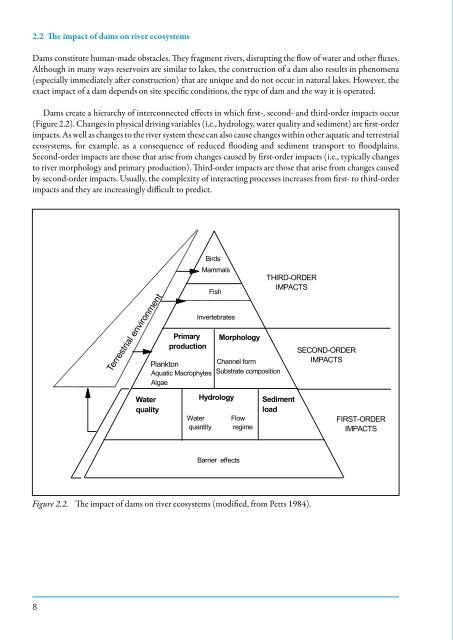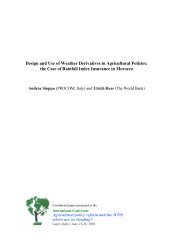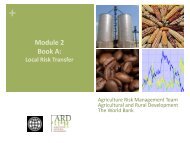Use of decision support systems to improve dam planning and dam ...
Use of decision support systems to improve dam planning and dam ...
Use of decision support systems to improve dam planning and dam ...
You also want an ePaper? Increase the reach of your titles
YUMPU automatically turns print PDFs into web optimized ePapers that Google loves.
2.2 The impact <strong>of</strong> <strong>dam</strong>s on river eco<strong>systems</strong><br />
construction <strong>of</strong> a <strong>dam</strong> also results in phenomena (especially immediately after<br />
Dams constitute human-made obstacles. They fragment rivers, disrupting the flow <strong>of</strong> water <strong>and</strong> other fluxes.<br />
construction) that are unique <strong>and</strong> do not occur in natural lakes. However, the exact impact<br />
Although in many ways reservoirs are similar <strong>to</strong> lakes, the construction <strong>of</strong> a <strong>dam</strong> also results in phenomena<br />
<strong>of</strong> a <strong>dam</strong> depends on site specific conditions, the type <strong>of</strong> <strong>dam</strong> <strong>and</strong> the way it is operated.<br />
(especially immediately after construction) that are unique <strong>and</strong> do not occur in natural lakes. However, the<br />
exact impact <strong>of</strong> a <strong>dam</strong> depends on site specific conditions, the type <strong>of</strong> <strong>dam</strong> <strong>and</strong> the way it is operated.<br />
Dams create a hierarchy <strong>of</strong> interconnected effects in which first-, second- <strong>and</strong> third-order<br />
Dams<br />
impacts<br />
create<br />
occur<br />
a hierarchy<br />
(Figure<br />
<strong>of</strong><br />
2.2).<br />
interconnected<br />
Changes<br />
effects<br />
in physical<br />
in which<br />
driving<br />
first-, secondvariables<br />
<strong>and</strong><br />
(i.e.,<br />
third-order<br />
hydrology,<br />
impacts<br />
water<br />
occur<br />
(Figure<br />
quality<br />
2.2).<br />
<strong>and</strong><br />
Changes<br />
sediment)<br />
in physical<br />
are<br />
driving<br />
first-order<br />
variables<br />
impacts.<br />
(i.e., hydrology,<br />
As well<br />
water<br />
as changes<br />
quality<br />
<strong>to</strong><br />
<strong>and</strong><br />
the<br />
sediment)<br />
river system<br />
are first-order<br />
these<br />
impacts. can also As well cause as changes changes <strong>to</strong> the within river system the terrestrial these can also system, cause changes for example, within other as aquatic a consequence <strong>and</strong> terrestrial <strong>of</strong><br />
eco<strong>systems</strong>, reduced for flooding example, <strong>and</strong> as a sediment consequence transport <strong>of</strong> reduced <strong>to</strong> floodplains. flooding <strong>and</strong> Second-order sediment transport impacts <strong>to</strong> floodplains. are those<br />
Second-order that arise impacts from are changes those that caused arise from by first-order changes caused impacts by first-order (i.e., typically impacts (i.e., changes typically <strong>to</strong> changes river<br />
<strong>to</strong> river morphology morphology <strong>and</strong> <strong>and</strong> primary production). Third-order Third-order impacts impacts are those are that those arise from that changes arise caused from<br />
by second-order changes caused impacts. by Usually, second-order the complexity impacts <strong>of</strong> interacting (i.e., typically processes changes increases from <strong>to</strong> flora first- <strong>to</strong> <strong>and</strong> third-order fauna).<br />
impacts Usually, <strong>and</strong> they the are complexity increasingly difficult <strong>of</strong> interacting <strong>to</strong> predict. processes increases from first- <strong>to</strong> third-order<br />
impacts <strong>and</strong> they are increasingly difficult <strong>to</strong> predict.<br />
Figure 2.2. The impact <strong>of</strong> <strong>dam</strong>s on river eco<strong>systems</strong> (modified, from Petts 1984).<br />
Figure 2.2. The impact <strong>of</strong> <strong>dam</strong>s on river eco<strong>systems</strong> (modified, from Petts 1984).<br />
Alter the first letter <strong>of</strong> Macrophytes <strong>to</strong> lower case. Alter form <strong>to</strong> forms. Lower case S <strong>of</strong><br />
Substrate. Align quantity <strong>and</strong> regime with their foregoing words.<br />
8<br />
Terrestrial environment<br />
Water<br />
quality<br />
Primary<br />
production<br />
Birds<br />
Plank<strong>to</strong>n<br />
Aquatic Macrophytes<br />
Algae<br />
Mammals<br />
Fish<br />
Invertebrates<br />
Water<br />
quantity<br />
Channel form<br />
Substrate composition<br />
Hydrology<br />
Morphology<br />
Barrier effects<br />
16<br />
Flow<br />
regime<br />
THIRD-ORDER<br />
IMPACTS<br />
Sediment<br />
load<br />
SECOND-ORDER<br />
IMPACTS<br />
FIRST-ORDER<br />
IMPACTS





